The role of Soviet aviation in the failure of Operation Brazil
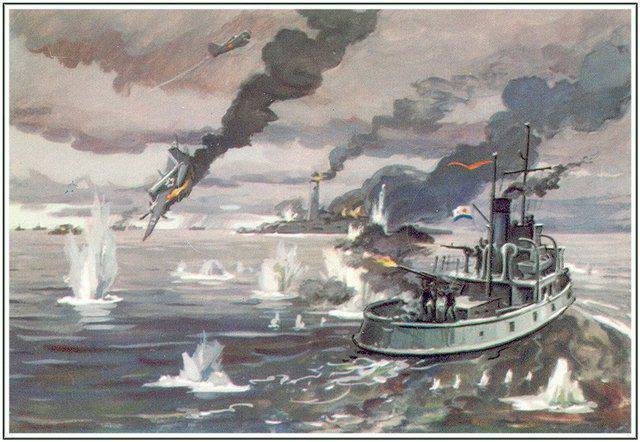
In late August - early September 1941, fascist troops, despite the stubborn resistance of the Soviet Army, captured Lyuban, Tosno, Mga station, Shlisselburg, reaching the Neva and Lake Ladoga. The blockade of Leningrad began. In order to deliver food, fuel and other goods to the city, evacuate deep into the country industrial enterprises and the population on Lake Ladoga, communications were created, called the Road of Life. Their uninterrupted operation required the organization of reliable protection, including air cover. So, providing transportation through Ladoga, only naval aviators in 1941-1942 completed more than 8000 sorties and conducted over 200 air battles. On the main lines of the alleged actions of the enemy aviation Soviet fighter guidance posts were equipped. The airspace above the lake lanes was divided into zones, which facilitated the management of aircraft groups, which provided cover for convoys and individual vessels.
To solve the tasks of the anti-airborne (PDO) and air defense (air defense) communications defense in the fall of 1941, the Ladoga Baltic Air Force was created fleet. The composition of the aviation units included in it, depending on the current situation, often changed. In the summer and autumn of 1942, for example, it included: the 11th fighter air regiment (IAP) - 14 I-15BIS and 8 I-16 aircraft at the airfields of Novaya Ladoga and Vystav; 12th Separate Fighter Squadron (OIAE) - 9 MiG-3 fighters at the Vystav aerodrome; The 58th squadron (ae), used as a night bomber, is 10 MBR-2 seaplanes based on the Novaya Ladoga hydroaerodrome.
Directly for the antiamphibious defense of the southern coastal areas of Ladoga, it was possible to use other units included in the Leningrad grouping of naval aviation, this is the 57 attack assault regiment (cap) - 9 Il-2, the Airfield Citizen; The 3 and 4 th Guards Fighter Aviation Regiments (HYAP) - the composition of the forces according to the situation and the 26-I separate reconnaissance squadron (Orae) - 6 Yak-1 and 5 Pe-2, Priyutino airfield. Each of these units performed specific tasks that were set by the fleet air force headquarters on a monthly basis, and according to the situation, were updated every day. So, 26-I separate reconnaissance squadron produced daily aerial reconnaissance of the lake. From 22 August to 23 October 1942, she performed for this purpose more 120 sorties. Over the same period, the 58 Squadron on the MBR-2 conducted reconnaissance and bombardment of the enemy's bases at night, while producing 52 aircraft.
Trying to disrupt transportation on the lake, the enemy aircraft, in turn, increased activity. Ship forces were also widely used. By August, 1942 had collected up to 30 amphibious high-speed barges and armed boats, 4 small mine layer, 5 torpedo boats and other warships and ships on Ladoga. All of them were consolidated into the united German-Finnish-Italian flotilla, which faced the following tasks: the destruction of our ships and ships sailing along the main road (Novaya Ladoga-Morye-Osinovets); setting minefields in the same area; destruction of vehicles engaged in transportation along the small route (Kobona-Osinovets) and in bases.
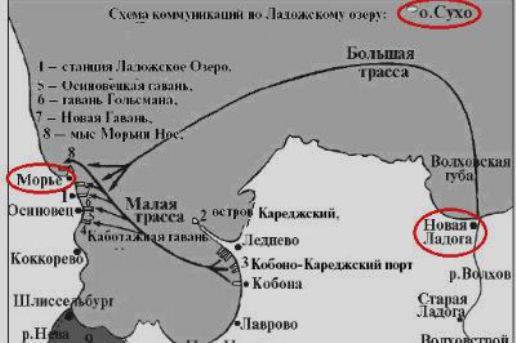
In the headquarters of the Ladoga military flotilla (LCF), taking into account the situation, they understood that the enemy had enough strength to ensure the landing of one of the important communication points in order to break or interrupt it. The flotilla headquarters, together with the fleet headquarters, developed additional measures to strengthen the antiamphibious defense, in particular, to conduct more intensive aerial reconnaissance and mine observation. In addition, aviation significantly increased the number of bombings and assault attacks on bases and moorings in Sortanlahti, Kexholm, Lakhdenpokhya, Sortavala, Salmi, and also in the skerries of the northern coast of the lake.
Soon the danger of active hostilities was confirmed. On the night of October 9, the 16 landing craft and the 7 patrol boats of the so-called flotilla of ferries under cover of 3 aircraft left Sortanlahti in order to attack counter convoys, scout the patrol system near the Volkhov Bay, and most importantly, test the strength and readiness of our anti-aircraft defense. As is now known, this was the first stage of the operation “Brazil” planned by the Germans to disrupt communications with the landing of a tactical landing force. The Soviet patrol boats, finding the enemy, imposed a battle on him, and the planes that took off on their call bombed. Several ships from the ferry fleet were damaged.
Operation Brazil itself was carried out on the night of October 22 1942. Taking advantage of the fact that, due to bad weather, our aircraft did not conduct reconnaissance for three days, the enemy secretly formed a landing party, landed it on ships and sent combat forces to Suho island. The detachment consisted of over 20 vessels, including 7 heavy, 4 light, several boats, as well as several transport, staff and sanitary barges.
The landing site was chosen by the enemy with all care. A small artificial island, which was created in the first half of the XVIII century in the southern shoals of the lake, had a very favorable location. Since near about. Sukhoi, covering the entrance to the water area of the Volkhov Bay, passed a large water route, then the seizure of the island made it possible for the Germans to exert the most active and direct influence on our transportation. In addition, the Soviet patrol ships in this case were deprived of artillery support (the coastal battery of 100-mm naval guns was located on the island), and convoys and aviation also had a convenient reference point, which was the lighthouse. The latter served as a pointer for landing craft. In 7 h 15 mines 22 October, approaching the island, the Nazi ships opened fire on him.
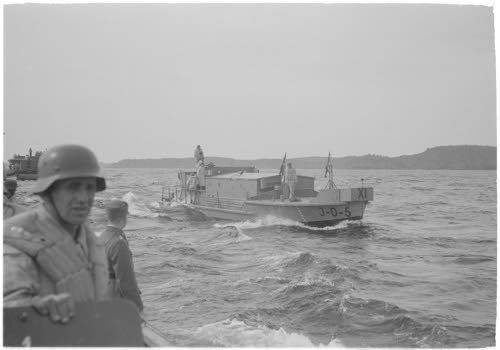
True, they didn’t catch the garrison by surprise, since the Post of the Surveillance and Communication Service (SNiS), located on about. Suho managed to detect an enemy squad of ships before. The gun crews of the coastal battery, which were on time alert, responded with fire. They were supported by Soviet patrol boats TSCH-100 and MO-171 on patrol. An hour later, enemy boats and inflatable boats under the cover of their ships and aircraft approached the coast and began to land. Since the radio station located on the island was out of order at the very beginning of the battle, the patrol ships sent the report to the flotilla headquarters about the enemy landing.
A permanent connection was established with the ships deployed on the lake, as well as with the headquarters of the Leningrad, Volkhov and Karelian fronts. The command of these fronts, promptly reacting to the situation, singled out aviation groups for strikes against enemy naval targets, and also began deploying land forces and units along the coast in accordance with anti-airborne defense plans.
Major-General M.I., Commander of the Air Force of the Baltic Fleet, headed the command of naval and front-line aviation operations Samokhin, who made the decision: by airplanes of the Ladoga and Leningrad air groups to carry out a series of consecutive concentrated attacks on the landing techniques of the fascists in the region of Fr. Dry. Monitoring of the landing in order to determine its composition, location and maneuver of ships, the state of the weather was entrusted to the crews of the 26 separate reconnaissance squadron. In 8 h 15 mines, the task was assigned to the commanders of the 8 th air brigade (Leningrad air group) Colonel E.N. Preobrazhensky, and 61-th air brigade (Ladoga air group) Colonel P. V. Kondratiev - to destroy the landing squad.
Within a few minutes, commanders of aviation units received instructions. For example, the 11 Fighter Aviation Regiment (Commander Major I.M. Rasdokov) had, using all operational aircraft, make multiple flights to the area of operations of the landing force and inflict bombster attacks on it, 12 separate fighter squadron (Commander Captain G. V. Kraynev) - cover shock groups.
Joint operations of naval and front-line aviation began after 57 minutes after the landing of an enemy landing. The reliability of the interaction, as well as the accuracy of the strikes, were ensured by the withdrawal of front-line aviation groups to enemy ships by the leaders of the naval air force. Total 12 strikes. The first of them was produced in 9 h 7 mines with the four I-15bis (lead captain S. S. Belyaev) from the Novaya Ladoga airfield without fighter cover, the second — after 13 minutes, also with the four I-15bis (lead captain AA Mironenko), operating under the cover of the six MiG-3. The appearance of our aircraft broke the situation, supported the defenders of Fr. Dry, already with difficulty restraining the onslaught of the enemy, and also brought confusion into the battle formations of the enemy. The fascists, bearing losses, began to retreat to the coastline, hastily boarding boats and boats. At half past ten the ships with the remnants of the landing on board departed from the island. Having built in the wake column, they, under the cover of German fighters, headed for Sortalahti.
Now the air strikes were delivered to the retreating enemy in order to destroy him. Under these conditions, a large load fell both on the flight and on the technical composition of the aviation units. For example, in the 11 Fighter Aviation Regiment, the preparation time for re-departure was reduced by the fact that by the time the fighters landed at the place of their stay, bombs and other ammunition were coming up, and tankers were coming up. The impact of aviation on the landing coincided with the entry of our ships into combat contact with the ships of the enemy. This imposed increased responsibility on the officers who carried out the interaction of disparate forces. Therefore, the naval air force headquarters, with all the thoroughness and scrupulousness, specified information on sea targets and, together with the weather data along the flight route, were communicated to flight crews.
Noteworthy is the eleventh strike, in which naval and front-line aviation operated (12 attack aircraft Il-2 and 20 fighters of various types). The accuracy of the aircraft on the target was provided by the leadership of the commander of the 57 assault air regiment, Lieutenant Colonel F.A. Morozov. Approximately an hour and a half before the combat mission he, under the cover of two Yak-1, flew to Il-2 from the airfield Citizen in Kasimovo, where he took part in the general gathering of front-attack aircraft and fighter jets. Under his leadership, was a short draw of the goal. The pilots also familiarized themselves with the characteristics and distinctive features (from photographs) of the enemy amphibious ships and Soviet ships that were at that moment in the battle area. Information about the change in the situation was transmitted by the crews who conducted the aerial reconnaissance. By the way, to perform reconnaissance tasks during the day, Soviet aircraft performed 5 sorties. Information obtained by reconnaissance aircraft largely ensured the accuracy of strikes against enemy ships. In 14 h 40 min fighters took off cover, after five minutes - twelve IL-2 and leader, with a cover of two Yak-1. Ahead was a leader Il-2, which exactly brought the group to the goal. The German assault force, already retired a considerable distance from the southern shore of the lake, was attacked by attack aircraft from low altitudes. As a result of the air strike, 3 barges were sunk. Another one was damaged by the leader Il-2 with two direct hits of missiles.
Departures were made and later for the application of the next attacks - the thirteenth and fourteenth. But they were unsuccessful, because with the onset of twilight and deterioration of visibility contact with the enemy was interrupted. However, the search for enemy ships was not stopped. He was led, in spite of the gathering darkness, by single flying boats MBR-2 from 58 air squadron, which made 7 aircraft sorties. Since no ships could be found on the lake, the bombs were dropped on spare targets.
Fight in the area of. Dryly led to the defeat of the landing and tangible losses of the enemy in the ship. The enemy lost 19 (according to other data - 17) landing barges and boats, i.e. half of their surface forces on Ladoga. Moreover, the largest number of enemy ships and ships was destroyed by aviation, which made 200 sorties in one day. For example, only on the account of the crews of the 57 th assault aviation regiment 7 destroyed ships. It should also be noted that the air strikes inflicted on the landing force were carried out under conditions of constant opposition from enemy aircraft. She lost 14 airplanes: 8 Bf.109, 2 Fiat G.50, 2 Caproni Sa.311, one Ju-88 and Do-215. Our losses: 2 IL-2, 2 I-15bis, 1 IL-2 (burned during a forced landing, but the pilot was still alive).
The fact that during the period of the landing of troops on Fr. Dryly, as well as at all stages of the battle on that day, a link was established between the coastal command post of the Ladoga military flotilla and Moscow. The General Staff was constantly interested in the situation in the area. In addition, on instructions from Moscow, the compound of the long-range bomber reserve of the Supreme High Command was ready to assist front and naval aviation.
The disruption of the German operation "Brazil" showed the important role of aviation in the air defense and antiamphibious defense of lake communications. It cost our aircraft due to bad weather to temporarily suspend the observation of the lake, ports, bases and moorings, as the enemy was able to secretly form a ship detachment, land landing, make the transition to the designated area. Our patrol ships were able to detect enemy ships with troops already near the island. The forced isolation of aviation at important stages of active anti-landing defense (reconnaissance, assault on landing points, impact on it at the crossing, assistance to the defensive garrison during enemy landing on the bridgehead) led to the temporary operation of Brazil. The landing, in spite of the fire of our naval and coastal artillery and the resistance of the garrison, managed not only to seize the coast, but also to go deeper into the territory of the island, to inflict considerable damage on its defenders, to mine one of the guns. But the appearance of Soviet combat aircraft made a turn in the course of the battle. Nevertheless, aviation played a decisive role only at the last stage of the antiamphibious defense of communication — the pursuit and the rout of the landing force.
Equally important was the interaction of naval and front-line aviation, as well as the unified management of their actions, which was carried out by the Commander of the Air Force BF through the command of commanders of aviation units and units. The accuracy of the strikes on the landing force was largely predetermined by the preliminary joint elaboration of the mission, the withdrawal of aircraft (especially front aviation) to the target by the leader — the sea pilot, and also, during the battle, air reconnaissance. Fight at about. Suho was the final failure of Operation Brazil. The combined flotilla of enemy ferries after it was never able to recover, and its presence on the lake was no longer noticed at all.
Sources:
Ammon G., Berezovsky N., Komarov A. Military Chronicle of the Navy. 1941-1942. M .: Voenizdat, 1992. C. 187-191.
Kovalchuk V. Protection of Traffic // Leningrad and the Big Earth. History Ladoga communication of blocked Leningrad in 1941-1943 M .: Science, 1975. C. 232-237.
Samsonov A. The Red Banner Baltic Fleet in the Great Patriotic War 1941-1945. M .: Science, 1981. C. 241-248.
Ermilov S. Aviation actions to disrupt the operation "Brazil" // Military history magazine. 1989. No.9. C. 27-31.
Epatko A. How Operation Brazilian Fails // St. Petersburg Gazette. 16 January 2013.
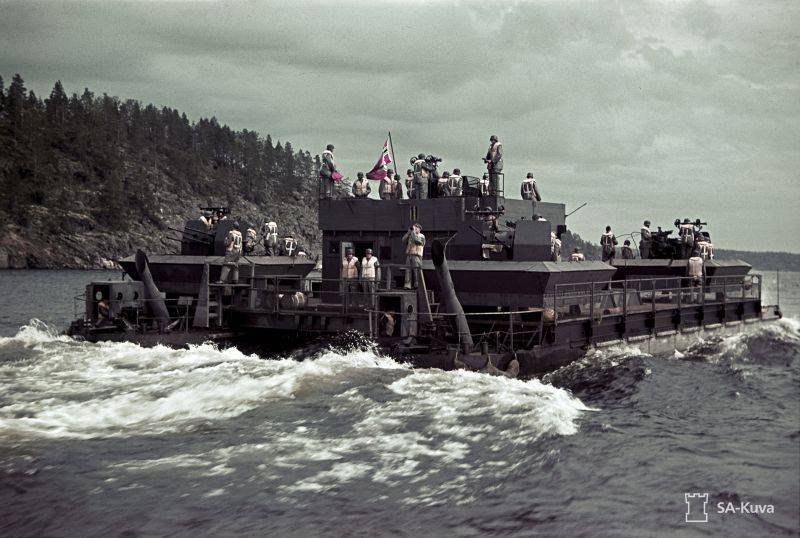
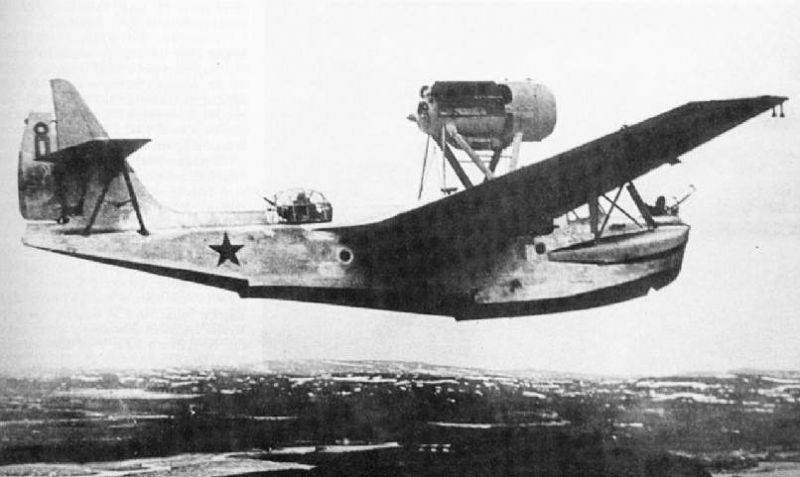
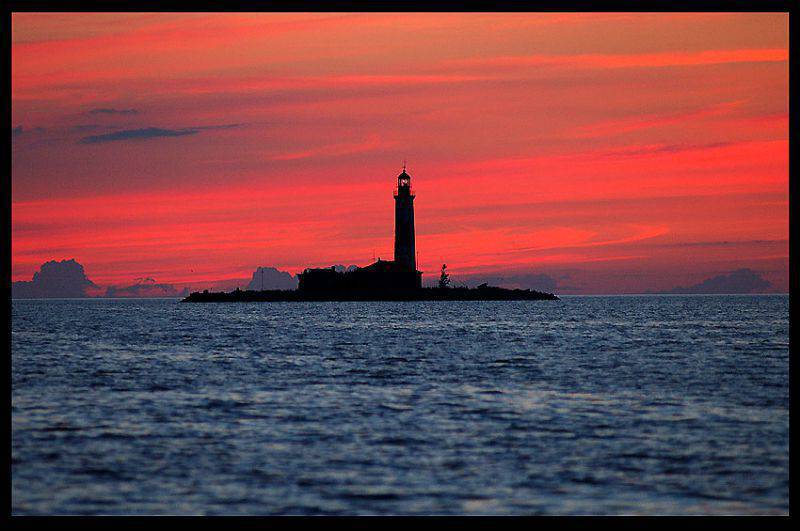
Information